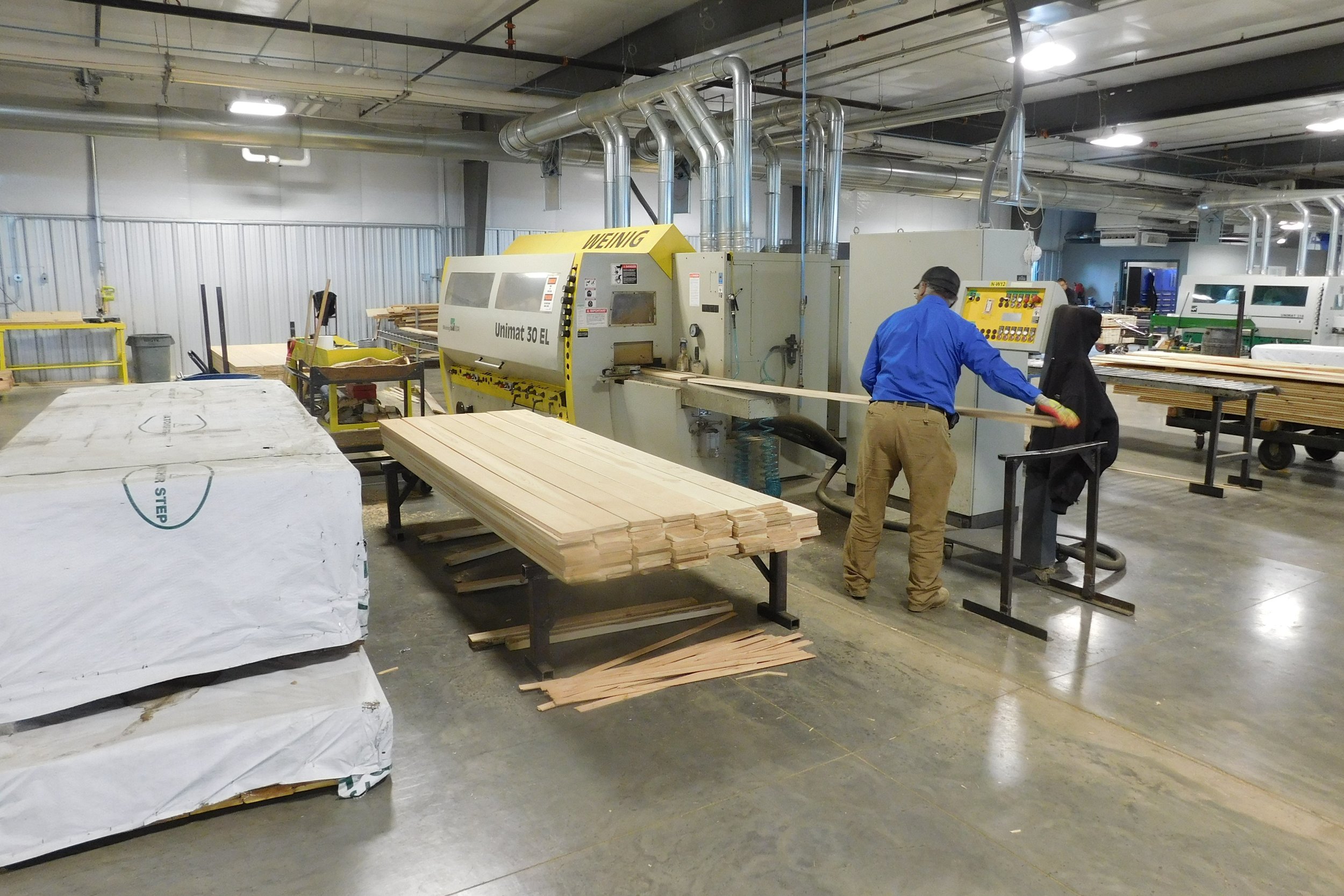General Building Materials
Forced to Move, General Building Materials Now Has Room to Grow
This Denver-area manufacturer seizes the moment by investing in more space and state-of-the-art dust collection after a massive city public works project pushes it out of its downtown digs.
General Building Materials’ new manufacturing facility in Commerce City, CO, is bigger, brighter, cleaner and far more efficient than its former home in Denver, 10 minutes from the state capital building.
A huge part of the company’s newly gained efficiency - when measured by increased productivity and lower utility bills - is owed to a pair of state-of-art dust collection systems installed by Hocker North America.
The $850,000 price tag of the two dust collection systems represents a major financial commitment for the 35-man operation. The investment was justified, however, not only to meet stricter dust collection standards but also to allow the company to keep its two distinct wood waste streams separate. For this latter reason, the larger dust collection system is dedicated to capturing moulder shavings that are packaged and sold to area horse farms. The smaller dust collection system is fully integrated with a briquetter and boiler to utilize low-value wood waste as fuel to heat the 55,000-square-foot facility.
City Comes a Callin’
When the city of Denver requested him to appear at a plan commission meeting a couple of years ago to learn about a $300 million flood mitigation project, Jon Montague, president of General Building Materials, got that sneaky feeling his family’s business was in the line of fire. His suspicions were quickly confirmed when he studied the city’s plans to construct an open storm-water channel extending from east to west across a large stretch of Downtown Denver.
“Unfortunately, every one of the plans I looked at seemed to go right through our building,” Montague says. Montague and his brother-in-law Russ Lowery, who runs GBM’s production, had several discussions to weigh their options. “We realized that we could either be very angry about this situation or seize it as an opportunity to jumpstart our business.”
Deciding it better to switch than to fight, Montague negotiated terms to sell and vacate the 37,000-square-foot facility his father Ron purchased more than 25 years ago. The deal included relocation benefits that GBM used to help construct a 25,000-square-foot addition to the Commerce City facility, install LED lighting, and install new dust collection.
“Being landlocked in downtown, we knew that ultimately the only way we would be able to grow our capacity would be to move. But it’s one thing to make such a big decision on your own terms and another to be told you have to vacate,” Montague says. “It was very stressful looking for a new facility and trying to service customers while transitioning production. Fortunately, we reached an amicable settlement and Denver was helpful in helping us get resettled.”
A Tale of Two Waste Streams
GBM manufactures decorative building products sold through nearly 100 retail lumberyards located throughout Colorado, plus some large OEM accounts, at its new 55,000-square-foot plant. The company exclusively uses cedar, pine and Douglas fir to make products that include tongue-and-groove siding, precision-end trim and mouldings.
The manufacturing plant is divided into two departments: cut shop and custom. The cut shop includes resaws, trim saws and a wood waste grinder. It produces more commodity-type products while also providing cut-to-size capabilities for custom products. The custom shop features four Weinig moulders and makes made-to-order profiled building products.
“About two-thirds of our products get moulded,” Montague says. “While we inventory some popular stock and tongue-and-groove products, we can add custom textures, like rough or hand-hewn, for example. Where everyone else’s capabilities stop, that’s where ours begins. Our custom shop has been able to add the most value to our customers and our business.”
Whereas the moulder operation produces a profitable byproduct sold for horse bedding, the cut shop waste has no commercial value. “The shavings from our moulder operations are big and fluffy – perfect for horse bedding,” Montague says. “The byproduct from the cut shop, however, is largely unusable,” Montague says. “It’s really fine dust from the saws and grind up from the chipper. About its only use is for mixing with manure.”
Montague said Hocker America was the only vendor to propose a two-dust-collector solution. “Although one system would work to service the entire plant, there is no way to separate the distinctly different byproducts from the two departments using just one large collector,” Montague says. “Hocker addressed our needs by proposing a two-system approach and adding a boiler system to heat our plant using the cut shop waste.”
A visit to JK Concepts, a Denver-based architectural woodwork company that installed a Hocker dust collection system a couple of years ago, cemented Montague’s decision to work with Hocker America.
New vs. Old Dust Collection
GBM’s former downtown location had five independent dust collectors of various makes and models. Most of them were added as the company’s business grew and new machines were added.
The custom shop dust collector has four independent motors and can achieve 36,000 cfm (cubic feet per minute) of airflow. The cut-shop dust collector installed by Hocker has two motors and a 24,000 cfm capacity. Both systems also feature Grecon spark suppression systems.
“The old systems did their job but were very inefficient compared to the Hocker collectors,” Montague says. “We’re now using maybe 60 percent of the cfm that was required before. If we had a collector connected to two machines and only one was running, we didn’t have blast gates to close off the machine that was not operating. It was 100 percent or zero.”
The automated blast gates are among many features that sold Montague on the Hocker dust control strategy. Hocker’s computer controller senses when a machine is operating or not and opens or closes the blast gate accordingly. Simultaneously the speed of the air conveying fan is ramped up or reduced to the air flow level required to extract dust particles from the machines that are running.
“With the Hocker system, when you turn on the first machine, the collector only services that one machine so it’s only running at a small percentage of full power,” Lowery says. “If you turn on another machine, the system ramps up a little more. When you turn a machine off, it adjusts and ramps down accordingly.”
Just as the blast gates have helped reduce electricity consumption, the boiler system has dramatically lowered GBM’s monthly gas bill. “We used to pay about $1,200 a month for gas and only heated 8,000 square feet of the old building during the winter,” Montague says. “Now we’re heating 37,000 square feet under roof and our average gas bill this past winter was about $200 per month.”
Montague notes that Hocker was the only dust collection vendor it talked with that was capable of supplying an integrated system to compress its low-grade wood waste into briquettes to fuel a boiler. An auger system automatically feeds briquettes from an enclosed storage room into the boiler.
The boiler system has closed the loop on GBM’s zero waste policy. “Our goal is to use 100 percent of our wood fiber. Any scrap at least 8 inches long gets made into survey stakes or other products. Anything smaller than 8 inches gets grinded and made into briquettes,” Montague says. “For a facility our size, even the trash companies are amazed. They just assume that we will have a container of waste a day but we might only have one a month.”
Lowery says the briquetter produced 275,000 between November 2017 when GBM completed its move to Commerce City and April 2018. “Right now, we’re producing about 250 pounds of briquettes per hour,” he says.
Increased Machine Run-Time
“We tell our guys all the time that the only time we make money is when we physically have lumber running through the machines,” Montague says. “Every minute a machine is not physically cutting something it’s costing us money.”
The Hocker dust collection systems have helped GBM boost production by reducing end-of-day clean up and eliminating machine downtime for emptying dust bins.
“We used to have to shut down all of the machines 30 to 40 minutes at the end of the day to clean up,” Lowery says. “It’s less than half of that now. We’ve gained about 20 minutes of productivity for each machine every day of the week mostly because of the greater efficiency of the new dust collectors. For example, the moulders have solid pipe that extends down to the cutter head. The waste goes right up the dust pipe. It’s a close, tight system.”
Even more importantly, Lpwery says the Hocker dust collection system has several “built-in redundancies” to eliminate unexpected shut downs. “At the old facility, for example, if we had a dust box that was full, we had to shut down the machines and physically disconnect the dust tubes and move them to connect to another box. That would idle two guys assigned to the moulder for anywhere from 15 to 30 minutes. We would never know when a machine was going to have to be shut down because of a box filling up. The boxes didn’t have windows or gauges to indicate that the box was nearly full. The new boxes for the new system not only windows, but a level sensor that alerts us when the box is almost full. We also now have a multiple box system. When one is full, the dust collector automatically shifts to an empty box. So, there is no machine downtime. We can empty the full box at the end of the shift.”
Another “redundancy” Lowery likes about the Hocker systems are the fact they have multiple motors. “In the past we had one dust collector with one motor dedicated to each moulder. If the motor went out, that moulder was down. Now if a motor were to go down on the big collector, we still have three other motors more than capable to addressing our dust extraction needs.” Lowery adds, “The computer rotates motor use to even out their wear.”
Super Clean Production Shop
From his vantage point as production manager, Lowery says the new dust collection systems make for a cleaner, healthier and safer work environment. “Knowing the amount of fine dust that machines like ours produce, and then realizing that none of it is going into the air, just boggles my mind.”
Montague goes a step further, opining that the combined efficiencies of the two Hocker dust collectors, briquetter and boiler system “makes our shop 10 times better than any woodshop I’ve ever seen.”
GBM’s dust collection systems also position the company for the long haul.
“We over-designed the system a little bit to accommodate future expansion,” Lowery says. He notes that expansion is coming sooner rather than later. A high-speed Weinig moulder is on order to make short order of GBM’s most popular profile mouldings.
“The system will easily accommodate the new moulder,” Lowery says. “When the time comes that we need to make an even more substantial expansion to our production, the Hocker system can grow with us. We can add two more motors to the large system. We won’t have to add another dust collection system.”

![JB1_20171218_00027_preview[1].jpeg](https://images.squarespace-cdn.com/content/v1/5ab0496e2714e5102a3bd3e1/1538526082932-M1G51LH8CP1DR00GBN5V/JB1_20171218_00027_preview%5B1%5D.jpeg)

![JB1_20171218_00084_preview[1].jpeg](https://images.squarespace-cdn.com/content/v1/5ab0496e2714e5102a3bd3e1/1538526153889-049PPHAC7T6ZU4JPLDLH/JB1_20171218_00084_preview%5B1%5D.jpeg)


![JB1_20171218_00042_preview[1].jpeg](https://images.squarespace-cdn.com/content/v1/5ab0496e2714e5102a3bd3e1/1538526275604-5E3U54ZMVGX5674NOSPL/JB1_20171218_00042_preview%5B1%5D.jpeg)

![JB1_20171218_00020-HDR_preview[1].jpeg](https://images.squarespace-cdn.com/content/v1/5ab0496e2714e5102a3bd3e1/1538526367175-1HMXSMMA6RM3QOZDBCJS/JB1_20171218_00020-HDR_preview%5B1%5D.jpeg)


